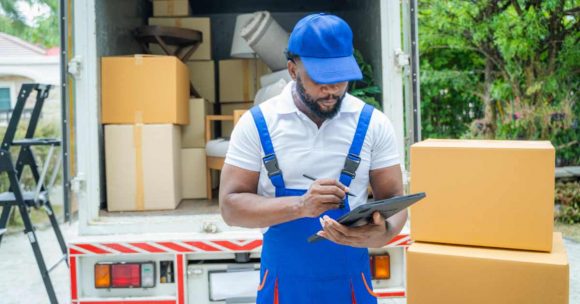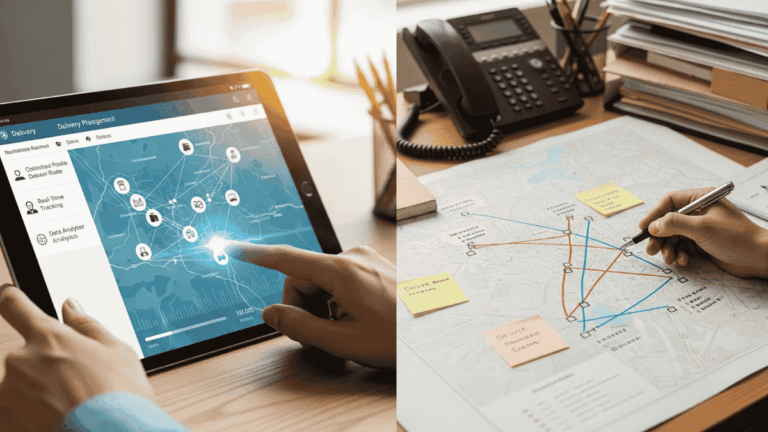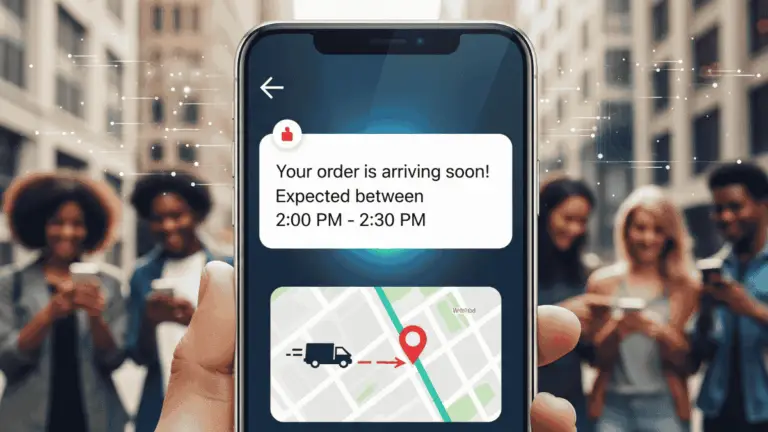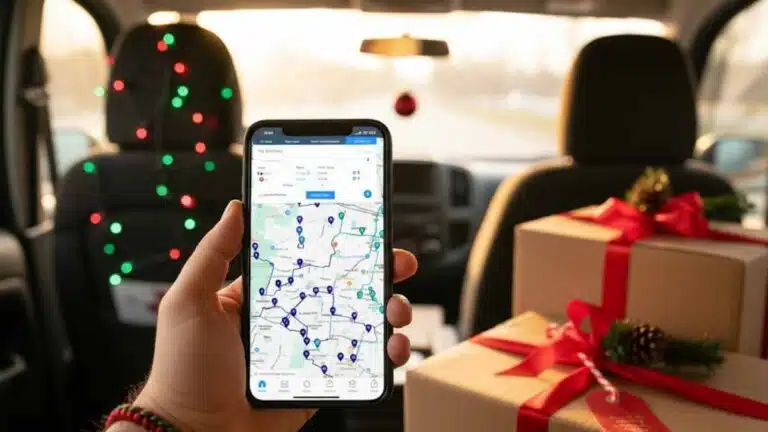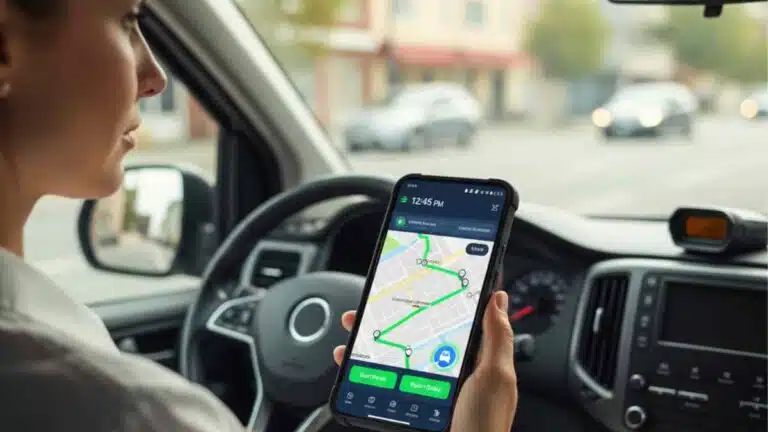A good Transport Management System (TMS) is so much more than just a fancy add-on for logistics companies. We are at a point now where it’s a necessity.
But even with a TMS that lacks the right features, businesses can still be hampered by delivery delays, rising costs, and frustrated customers.
So, what makes a transport management system genuinely effective? This guide breaks down the 12 essential features every TMS should include.
First, let’s do a refresher on what a transport management system is, and why your business should invest in one.
What is a transportation management system?
The short answer: A TMS is software that helps businesses manage logistics and transportation operations.
Use it to plan, execute, and track deliveries. But beyond that, it also ensures the items out for delivery reach their destinations in the most efficient way possible.
You might wonder why you need yet another piece of software for this, but the logistics and delivery industries are evolving fast.
Companies that don’t adopt modern transportation solutions risk falling behind.
Don’t take our word for it. According to a Mordor Intelligence report, the global TMS market is estimated at $2.27 as of 2025. It is projected to grow at a CAGR of 8.92% through 2030.
READ: Transport Management System Explained: What You Need to Know
15 Essential features every TMS needs
Now that we’ve looked at how vital it is for businesses to have a TMS, let’s dive into the critical features a Transport Management System should have.
1. Route optimization
A good TMS must include a robust route planning solution. This is called route optimization, an algorithmic-based software that finds the most efficient routes for deliveries.
Route optimization not only reduces fuel consumption; it also cuts costs, and ensures on-time deliveries so your customers can get a premium experience.
2. Real-time tracking
Tracking shipments as they move prevents lost deliveries and improves accuracy. But more than that, real-time tracking gives your customers peace of mind, knowing they don’t have to wait around all day for a delivery.
A transport management system should provide live GPS tracking so that both fleet- or logistics managers and customers can monitor the status of the shipment.
READ MORE: GPS Tracking Software Guide: How It Works and Why You Need It
3. Multi-modal transport support
Businesses often use trucks, rail, air, and sea freight to move goods. And it can be hard to manage logistics with such a diversified fleet.
So, when looking for a transport management system, you’ll need one that supports multi-modal logistics.
Why? For a seamless and painless transition between different transportation methods.
4. Carrier management
Most logistics managers will tell you that managing multiple carriers manually can be a nightmare in itself.
But with a transport management system, they’d now be able to compare rates and track performance.
By selecting the best carriers for your needs, you eliminate unnecessary costs down the line, as well as the headache of working with a system that doesn’t fit your business’s needs.
5. Automated dispatching
Manual dispatching leads to inefficiencies. And inefficiencies lead to a loss of profit, a waste of time, and a gap for human error to creep in.
With automated dispatch, a TMS assigns shipments to available drivers based on location, workload, and priority.
And if your software can allocate shipments based on your vehicles’ capacity, all the better!
This brings us to load optimization.
6. Load optimization
A well-packed vehicle saves space and reduces transportation costs.
TMS solutions should include load optimization tools to ensure vehicles are fully utilized without exceeding weight limits. It also works the other way around, making sure you’re not running a loss by under-loading vehicles.
With software like Locate2u’s, where you can configure the capacity for each of your vehicles, you essentially eliminate most of the inefficiencies that cripple delivery businesses.
7. Electronic proof of delivery (POD)
Drivers should be able to collect digital signatures and photos upon delivery. It sounds like such a small, unnecessary step, but trust us, proof of delivery is an essential feature.
By capturing digital proof of delivery, you can prevent disputes before they even take place.
And having the digital copies on hand will give you the verifiable proof of you need, should a customer complaint escalate.
8. AI-powered predictive analytics
Predictive analytics help identify trends, prevent bottlenecks, and improve efficiency.
By using artificial intelligence-driven TMS software, you can forecast delivery times more accurately. You can also manage fuel consumption and prepare for any potential delays.
9. Customer portal for self-service tracking
Customers expect – no, they demand – transparency and control over their deliveries. By sending them a Locate2u live tracking link, they’ll see in real-time when the driver will arrive.
A self-service tracking portal like this allows them to be aware of the status of their delivery during the entire process, which reduces the possibility of a missed delivery.
MORE HERE: What is real time tracking? Complete guide for modern logistics
10. API and system integration
A TMS should integrate with other business software, such as Enterprise Resource Planning (ERP), Warehouse Management System (WMS), and Customer Relationship Management (CRM) systems.
This prevents data silos, where data is stored in a what that is isolated from other systems or departments within your business. Data silos prevent easy access to information across an organization.
Besides, you’d want something that works with your existing process so there are no hangups or issues when you scale your company.
11. Automated billing and invoicing
A strong transport management system should also be able to handle freight audits, invoicing, and payment processing.
Not only does this reduce paperwork and the frustration that goes with it, it also minimizes billing and human error.
12. Fuel management and cost tracking
Keeping fuel costs low is critical for profitability, but it’s also one of the biggest pain points for logistics management since it’s so hard to gauge and keep track of.
With a transport management system, you can easily configure the platform with your vehicle’s details to track fuel usage.
This will also monitor driver behavior and how it impacts on fuel efficiency so you know when additional training is needed.
This will save you so much in the long run as you start cutting down on excessive fuel spend.
HOW TO SAVE EVEN MORE WITH TMS: 8 Ways Small Businesses Can Leverage TMS Without Breaking the Bank
Final takeaways on TMS must-haves
A modern TMS should do more than just track shipments.
It should automate, optimize, and improve every aspect of your logistics operation.
By ensuring your TMS has these 15 essential features, your business can save time, cut costs, and deliver a better customer experience.
Ready to upgrade your fleet? Start a free trial today.
About the author
Cheryl has contributed to various international publications, with a fervor for data and technology. She explores the intersection of emerging tech trends with logistics, focusing on how digital innovations are reshaping industries on a global scale. When she's not dissecting the latest developments in AI-driven innovation and digital solutions, Cheryl can be found gaming, kickboxing, or navigating the novel niches of consumer gadgetry.

